| CHAPTER IX.
SELECTION OF THE MOTOR. Flying Machines: Construction and Operation: A Practical Book Which Shows, in Illustrations, Working Plans and Text, How to Build and Navigate the Modern Airship. | ||
9. CHAPTER IX.
SELECTION OF THE MOTOR.
Motors for flying machines must be light in weight, of great strength, productive of extreme speed, and positively dependable in action. It matters little as to the particular form, or whether air or water cooled, so long as the four features named are secured. There are at least a dozen such motors or engines now in use. All are of the gasolene type, and all possess in greater or lesser degree the desired qualities. Some of these motors are:
Renault—8-cylinder, air-cooled; 50 horse power; weight 374 pounds.
Fiat—8-cylinder, air-cooled; 50 horse power; weight 150 pounds.
Farcot—8-cylinder, air-cooled; from 30 to 100 horse power, according to bore of cylinders; weight of smallest, 84 pounds.
R. E. P.—10-cylinder, air-cooled; 150 horse power; weight 215 pounds.
Gnome—7 and 14 cylinders, revolving type, air-cooled; 50 and 100 horse power; weight 150 and 300 pounds.
Darracq—2 to 14 cylinders, water cooled; 30 to 200 horse power; weight of smallest 100 pounds.
Wright—4-cylinder, water-cooled; 25 horse power; weight 200 pounds.
Antoinette—8 and 16-cylinder, water-cooled; 50 and 100 horse power; weight 250 and 500 pounds.
E. N. V.—8-cylinder, water-cooled; from 30 to 80
Curtiss—8-cylinder, water-cooled; 60 horse power; weight 300 pounds.
Average Weight Per Horse Power.
It will be noticed that the Gnome motor is unusually light, being about three pounds to the horse power produced, as opposed to an average of 4 1/2 pounds per horse power in other makes. This result is secured by the elimination of the fly-wheel, the engine itself revolving, thus obtaining the same effect that would be produced by a fly-wheel. The Farcot is even lighter, being considerably less than three pounds per horse power, which is the nearest approach to the long-sought engine equipment that will make possible a complete flying machine the total weight of which will not exceed one pound per square foot of area.
How Lightness Is Secured.
Thus far foreign manufacturers are ahead of Americans in the production of light-weight aerial motors, as is evidenced by the Gnome and Farcot engines, both of which are of French make. Extreme lightness is made possible by the use of fine, specially prepared steel for the cylinders, thus permitting them to be much thinner than if ordinary forms of steel were used. Another big saving in weight is made by substituting what are known as "auto lubricating" alloys for bearings. These alloys are made of a combination of aluminum and magnesium.
Still further gains are made in the use of alloy steel tubing instead of solid rods, and also by the paring away of material wherever it can be done without sacrificing strength. This plan, with the exclusive use of the best
Multiplicity of Cylinders.
Strange as it may seem, multiplicity of cylinders does not always add
proportionate weight. Because a 4-cylinder motor weighs say 100 pounds,
it does not necessarily follow that an 8-cylinder equipment will weigh
200 pounds. The reason of this will be plain when it
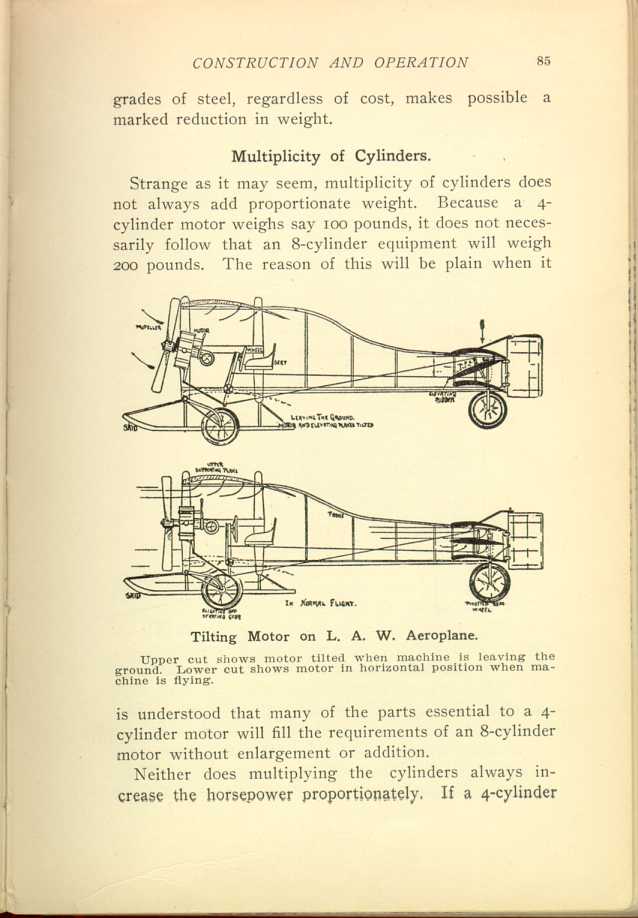
Tilting Motor on L. A. W. Aeroplane.
[Description: Black and white illustration: Two-part diagram of aeroplane
with tilting motor and propeller.]
Upper cut shows motor tilted when machine is leaving the ground. Lower
cut shows motor in horizontal position when machine is flying.
Neither does multiplying the cylinders always increase the horsepower proportionately. If a 4-cylinder
Horse Power and Speed.
Speed is an important requisite in a flying-machine
motor, as the velocity of the aeroplane is a vital factor
in flotation. At first thought, the propeller and similar
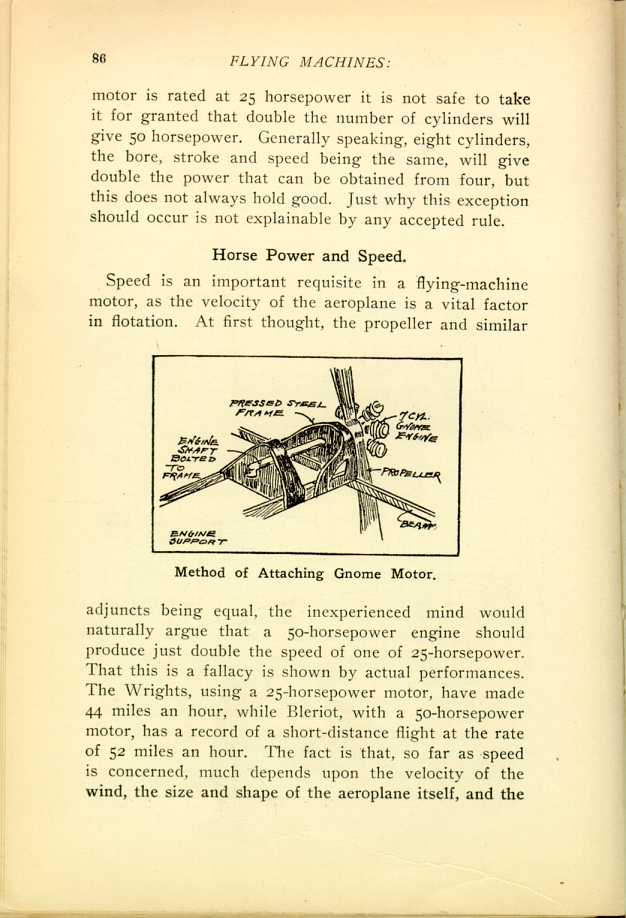
Method of Attaching Gnome Motor.
[Description: Black and white illustration: Diagram of motor seating.]
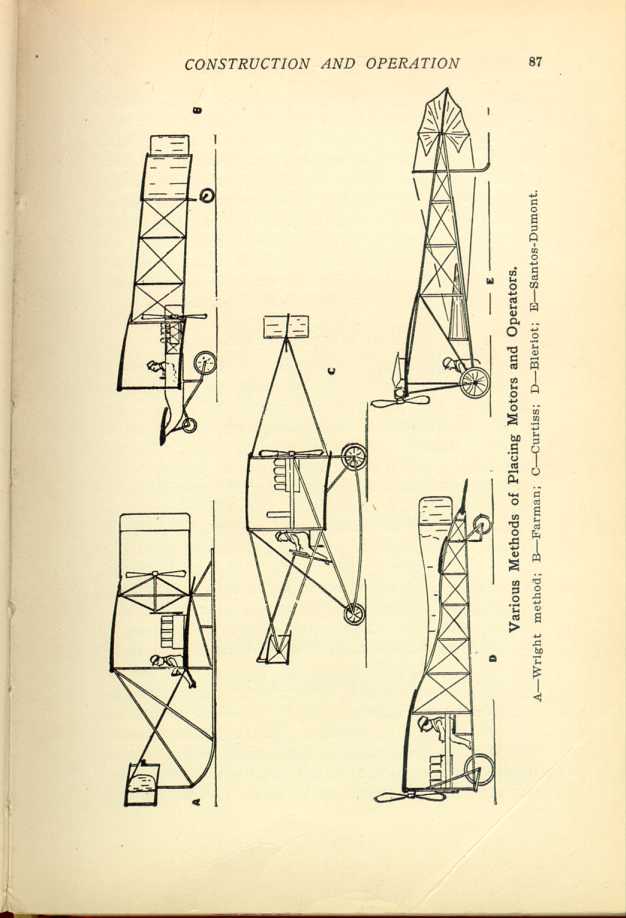
Various Methods of Placing Motors and Operators.
A—Wright method; B—Farman; C—Curtiss; D—Bleriot; E—Santos-Dumont.
[Description: Black and white illustration: Five models of aeroplane,
showing motor placement.]
Great Waste of Power.
One thing is certain—even in the most efficient of modern aerial motors there is a great loss of power between the two points of production and effect. The Wright outfit, which is admittedly one of the most effective in use, takes one horsepower of force for the raising and propulsion of each 50 pounds of weight. This, for a 25-horsepower engine, would give a maximum lifting capacity of 1250 pounds. It is doubtful if any of the higher rated motors have greater efficiency. As an 8-cylinder motor requires more fuel to operate than a 4-cylinder, it naturally follows that it is more expensive to run than the smaller motor, and a normal increase in capacity, taking actual performances as a criterion, is lacking. In other words, what is the sense of using an 8-cylinder motor when one of 4 cylinders is sufficient?
What the Propeller Does.
Much of the efficiency of the motor is due to the form and gearing of the propeller. Here again, as in other vital parts of flying-machine mechanism, we have a wide divergence of opinion as to the best form. A fish makes progress through the water by using its fins and tail;
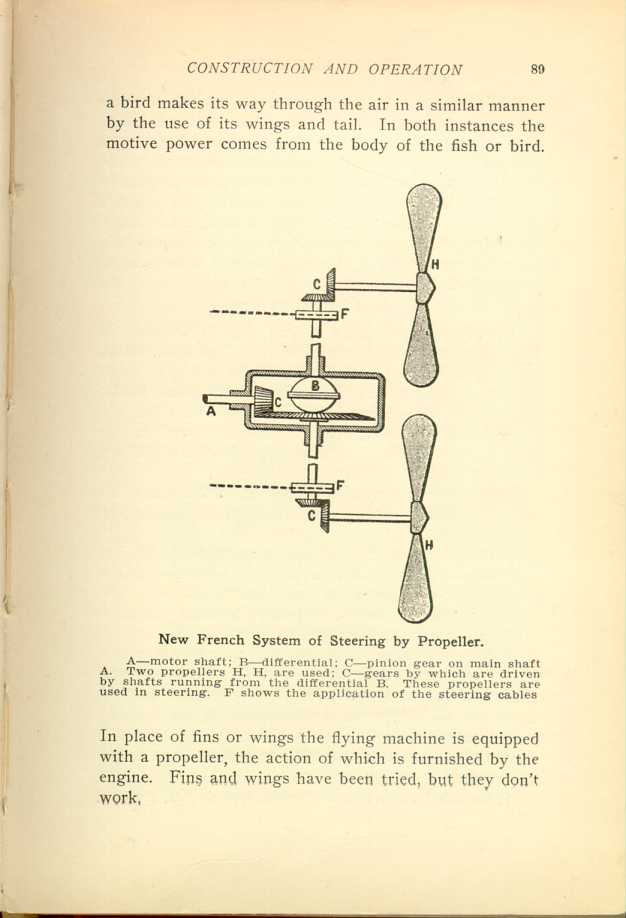
New French System of Steering by Propeller.
A—motor shaft; B—differential; C—pinion gear on main shaft A. Two
propellers H, H, are used; C—gears by which are driven by shafts
running from the differential B. These propellers are used in steering.
F shows the application of the steering cables
[Description: Black and white illustration: Diagram showing two propellers
and steering device.]
While operating on the same general principle, aerial propellers are much larger than those used on boats. This is because the boat propeller has a denser, more substantial medium to work in (water), and consequently can get a better "hold," and produce more propulsive force than one of the same size revolving in the air. This necessitates the aerial propellers being much larger than those employed for marine purposes. Up to this point all aviators agree, but as to the best form most of them differ.
Kinds of Propellers Used.
One of the most simple is that used by Curtiss. It consists of two pear-shaped blades of laminated wood, each blade being 5 inches wide at its extreme point, tapering slightly to the shaft connection. These blades are joined at the engine shaft, in a direct line. The propeller has a pitch of 5 feet, and weighs, complete, less than 10 pounds. The length from end to end of the two blades is 6 1/2 feet.
Wright uses two wooden propellers, in the rear of his biplane, revolving in opposite directions. Each propeller is two-bladed.
Bleriot also uses a two-blade wooden propeller, but it is placed in front of his machine. The blades are each about 3 1/2 feet long and have an acute "twist."
Santos-Dumont uses a two-blade wooden propeller, strikingly similar to the Bleriot.
On the Antoinette monoplane, with which good records have been made, the propeller consists of two spoon-shaped pieces of metal, joined at the engine shaft in front, and with the concave surfaces facing the machine.
The propeller on the Voisin biplane is also of metal, consisting of two aluminum blades connected by a forged steel arm.
Maximum thrust, or stress—exercise of the greatest
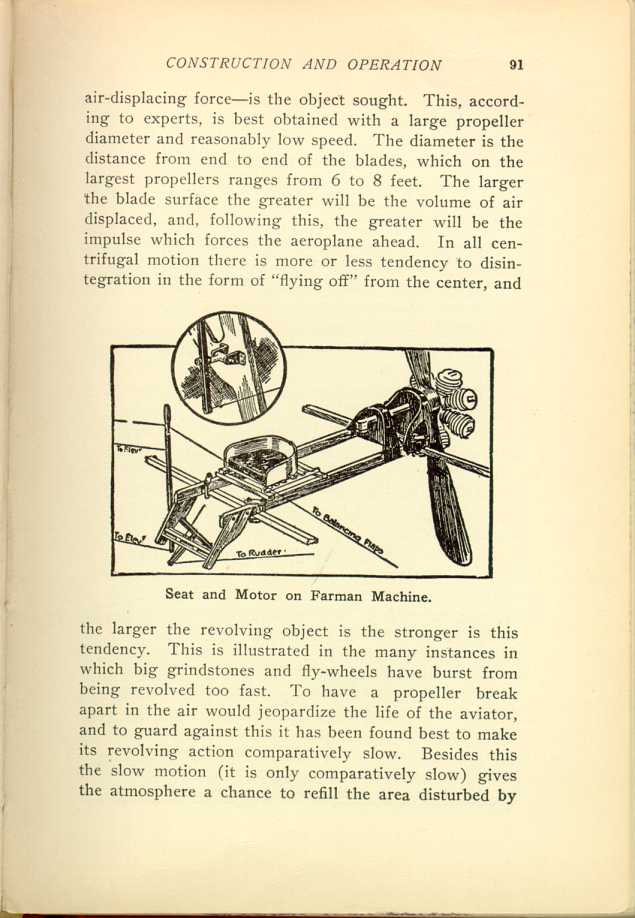
Seat and Motor on Farman Machine.
[Description: Black and white illustration: Motor and seating.]Placing of the Motor.
As on other points, aviators differ widely in their ideas as to the proper position for the motor. Wright locates his on the lower plane, midway between the front and rear edges, but considerably to one side of the exact center. He then counter-balances the engine weight by placing his seat far enough away in the opposite direction to preserve the center of gravity. This leaves a space in the center between the motor and the operator in which a passenger may be carried without disturbing the equilibrium.
Bleriot, on the contrary, has his motor directly in front and preserves the center of gravity by taking his seat well back, this, with the weight of the aeroplane, acting as a counter-balance.
On the Curtiss machine the motor is in the rear, the forward seat of the operator, and weight of the horizontal rudder and damping plane in front equalizing the engine weight.
No Perfect Motor as Yet.
Engine makers in the United States, England, France and Germany are all seeking to produce an ideal motor for aviation purposes. Many of the productions are highly creditable, but it may be truthfully said that none of them quite fill the bill as regards a combination of the minimum of weight with the maximum of reliable maintained power. They are all, in some respects, improvements upon those previously in use, but the great end sought for has not been fully attained.
One of the motors thus produced was made by the French firm of Darracq at the suggestion of Santos Dumont,
There can be no question as to the ability and skill
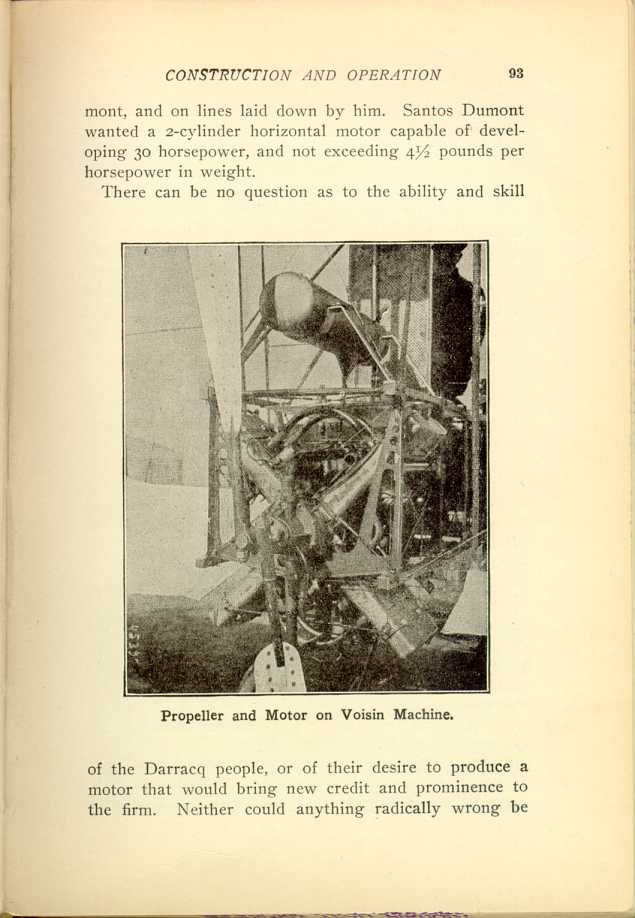
Propeller and Motor on Voisin Machine.
[Description: Black and white photograph: Propeller and motor.]
It could not be depended upon to deliver an energy of 30 horsepower continuously for any length of time. Its maximum power could be secured only in "spurts."
This tends to show how hard it is to produce an ideal motor for aviation purposes. Santos Dumont, of undoubted skill and experience as an aviator, outlined definitely what he wanted; one of the greatest designers in the business drew the plans, and the famous house of Darracq bent its best energies to the production. But the desired end was not fully attained.
Features of Darracq Motor.
Horizontal motors were practically abandoned some time ago in favor of the vertical type, but Santos Dumont had a logical reason for reverting to them. He wanted to secure a lower center of gravity than would be possible with a vertical engine. Theoretically his idea was correct as the horizontal motor lies flat, and therefore offers less resistance to the wind, but it did not work out as desired.
At the same time it must be admitted that this Darracq motor is a marvel of ingenuity and exquisite workmanship. The two cylinders, having a bore of 5 1-10 inches and a stroke of 4 7-10 inches, are machined out of a solid bar of steel until their weight is only 8 4-5 pounds complete. The head is separate, carrying the seatings for the inlet and exhaust valves, is screwed onto the cylinder, and then welded in position. A copper water-jacket is fitted, and it is in this condition that the weight of 8 4-5 pounds is obtained.
On long trips, especially in regions where gasolene is hard to get, the weight of the fuel supply is an important feature in aviation. As a natural consequence flying
An American inventor, Ramsey by name, is working
on a motor which is said to possess great possibilities
in this line. Its distinctive features include a connecting
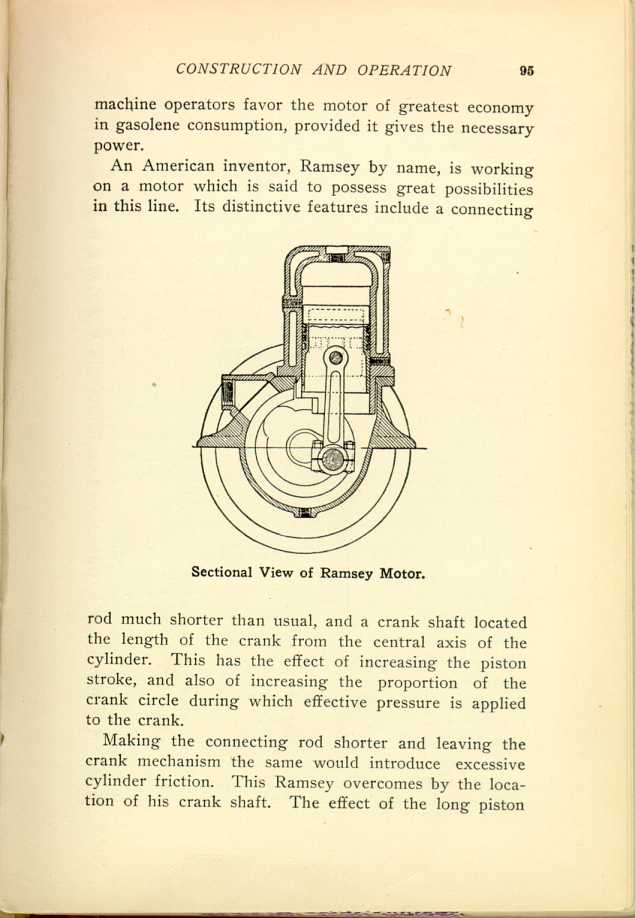
Sectional View of Ramsey Motor.
[Description: Black and white illustration: Cross-section of motor.]
Making the connecting rod shorter and leaving the crank mechanism the same would introduce excessive cylinder friction. This Ramsey overcomes by the location of his crank shaft. The effect of the long piston
Propeller Thrust Important.
There is one great principle in flying machine propulsion which must not be overlooked. No matter how powerful the engine may be unless the propeller thrust more than overcomes the wind pressure there can be no progress forward. Should the force of this propeller thrust and that of the wind pressure be equal the result is obvious. The machine is at a stand-still so far as forward progress is concerned and is deprived of the essential advancing movement.
Speed not only furnishes sustentation for the airship, but adds to the stability of the machine. An aeroplane which may be jerky and uncertain in its movements, so far as equilibrium is concerned, when moving at a slow gait, will readily maintain an even keel when the speed is increased.
Designs for Propeller Blades.
It is the object of all men who design propellers to obtain the maximum of thrust with the minimum expenditure of engine energy. With this purpose in view many peculiar forms of propeller blades have been evolved. In theory it would seem that the best effects could be secured with blades so shaped as to present a thin (or cutting) edge when they come out of the wind, and then at the climax of displacement afford a maximum of surface so as to displace as much air as possible. While this is the form most generally favored there are others in successful operation.
There is also wide difference in opinion as to the equipment of the propeller shaft with two or more
Difference in Propeller Efficiency.
That there is a great difference in propeller efficiency is made
readily apparent by the comparison of effects
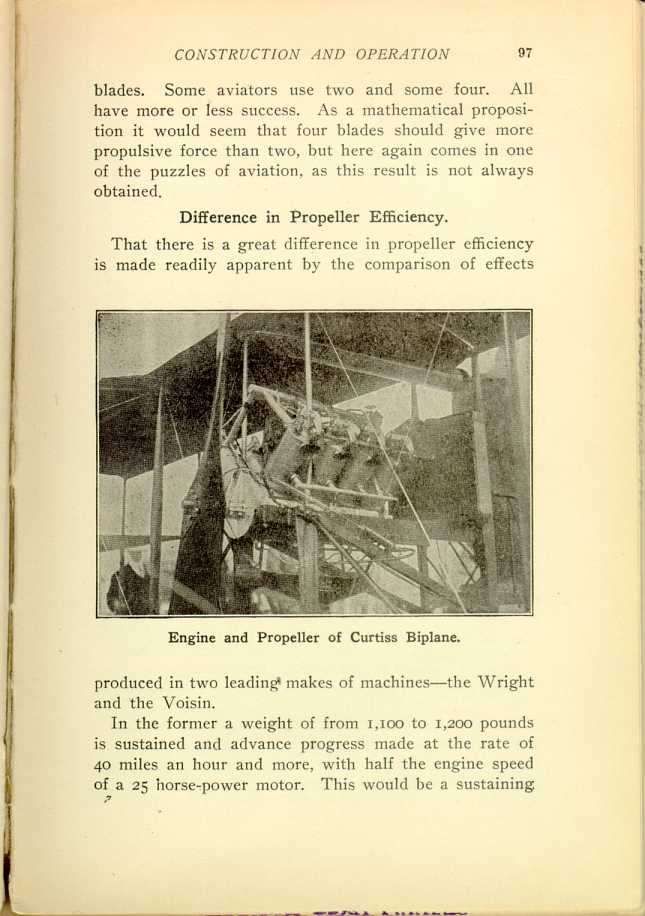
Engine and Propeller of Curtiss Biplane.
[Description: Black and white photograph: Engine and propeller.]
In the former a weight of from 1,100 to 1,200 pounds is sustained and advance progress made at the rate of 40 miles an hour and more, with half the engine speed of a 25 horse-power motor. This would be a sustaining
The Voisin machine, with aviator, weighs about 1,370
pounds, and is operated with a so-horsepower motor.
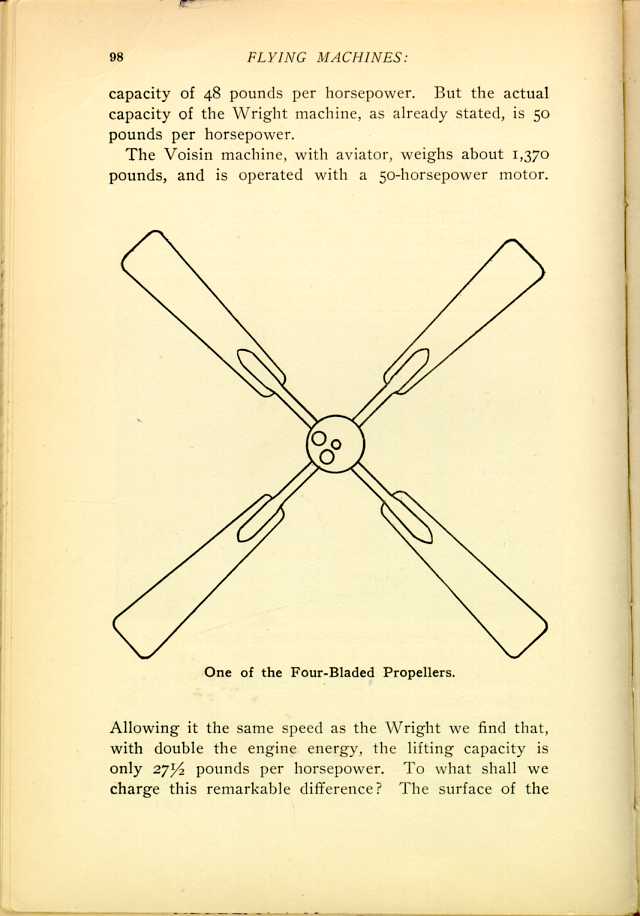
One of the Four-Bladed Propellers.
[Description: Black and white illustration: Four-blade propeller.]
Comparison of Two Designs.
On the Wright machine two wooden propellers of
two blades each (each blade having a decided "twist")
are used. As one 25 horsepower motor drives both propellers
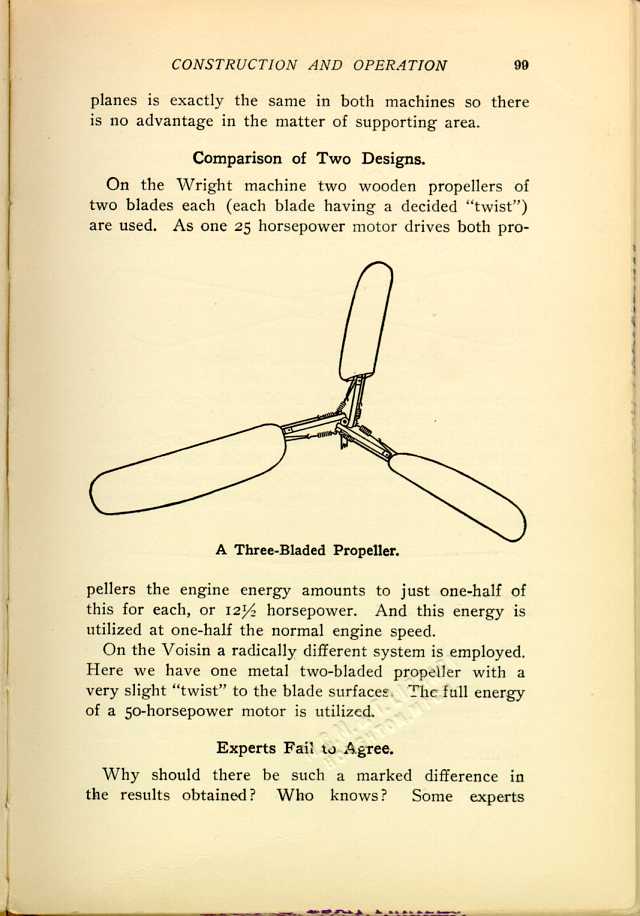
A Three-Bladed Propeller.
[Description: Black and white illustration: Three-blade propeller.]
On the Voisin a radically different system is employed. Here we have one metal two-bladed propeller with a very slight "twist" to the blade surfaces. The full energy of a 50-horsepower motor is utilized.
Experts Fail to Agree.
Why should there be such a marked difference in the results obtained? Who knows? Some experts
Other experts argue that the difference in results
may
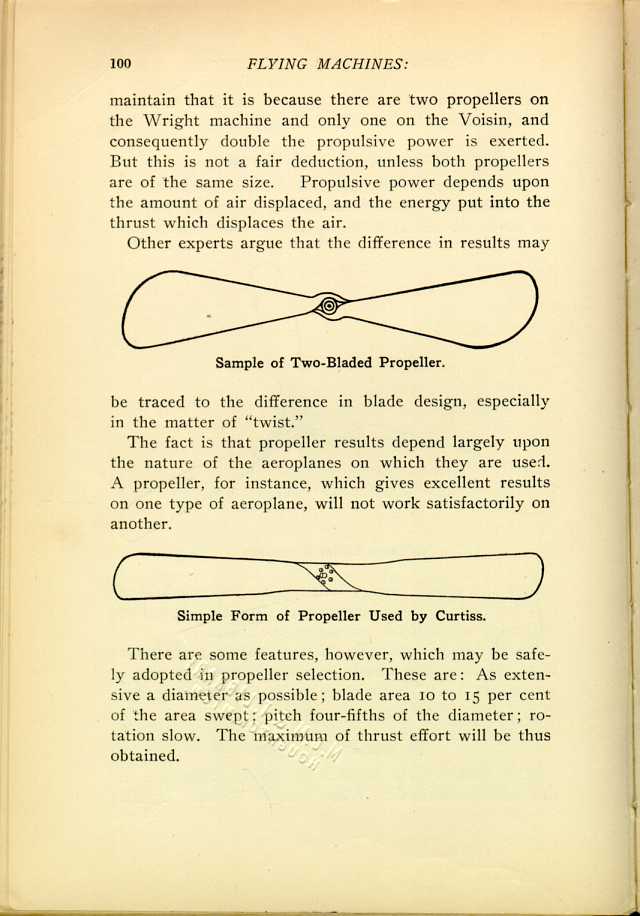
Sample of Two-Bladed Propeller.
[Description: Black and white illustration: Two-blade propeller.]
The fact is that propeller results depend largely upon the nature
of the aeroplanes on which they are used. A propeller, for instance,
which gives excellent results on one type of aeroplane, will not work
satisfactorily on another.
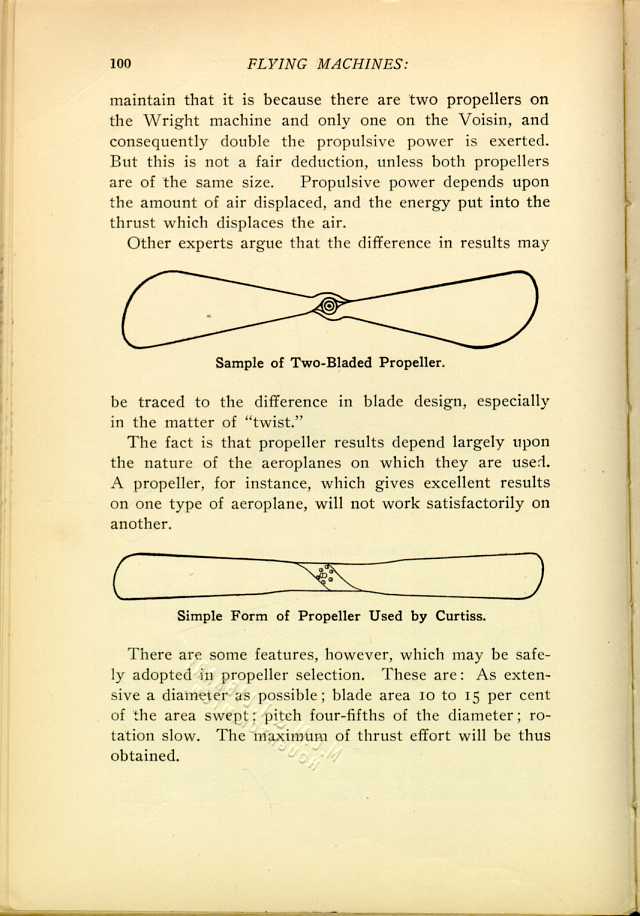
Simple Form of Propeller Used by Curtiss.
[Description: Black and white illustration: Simple one-piece propeller.]
There are some features, however, which may be safely adopted in propeller selection. These are: As extensive a diameter as possible; blade area 10 to 15 per cent of the area swept; pitch four-fifths of the diameter; rotation slow. The maximum of thrust effort will be thus obtained.
| CHAPTER IX.
SELECTION OF THE MOTOR. Flying Machines: Construction and Operation: A Practical Book Which Shows, in Illustrations, Working Plans and Text, How to Build and Navigate the Modern Airship. | ||